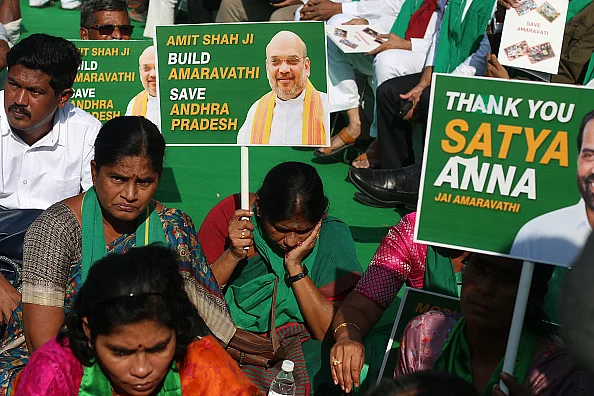Ten years ago, the undivided state of Andhra Pradesh witnessed violent riots, bandhs and a movement for a separate state of Telangana. When the new state was formed, it still shared links with Andhra, under the Andhra Pradesh Reorganisation Act 2014 which allowed Hyderabad to be the joint capital for both states. However, from June 2, 2024, Hyderabad solely belongs to Telangana, leaving Andhra muddled in a political conflict over its capital.
As Hyderabad Ceases To Be Joint Capital, Andhra Pradesh’s 10-year Long Capital Dilemma Continues
As Hyderabad ceases to be the joint capital, Andhra Pradesh grapples with a decade-long dilemma over its capital city.

The aforementioned bifurcation act, passed by Parliament in February 2014, fulfilled a long-standing demand for statehood for Telangana, that was officially realised on 2 June 2014. The Act stated, “On and from the appointed day (2 June 2014), Hyderabad in the existing State of Andhra Pradesh, shall be the common capital of the State of Telangana and the State of Andhra Pradesh for such period not exceeding ten years.” It further added, “After the expiry of the period referred to in sub-section (1), Hyderabad shall be the capital of the State of Telangana and there shall be a new capital for the State of Andhra Pradesh.”
The transition on June 2, 2024, marked the end of a decade during which Hyderabad functioned as the shared capital for both states.
Political turmoil over Andhra’s capital
If one does a simple google search on ‘What is the capital of Andhra Pradesh’, the search engine will give you one answer – Amaravati. However, it isn’t all that simple.
On October 22, 2015, Amaravati city in Guntur district was declared as the capital of Andhra Pradesh by the then Chief Minister Chandrababu Naidu of the Telugu Desam Party. In the subsequent years, work to develop Amaravati as a capital city began on the lines of Naidu's plan: building nine theme cities and 27 townships. The plan however, was halted after the YS Jagan Mohan Reddy-led YSRCP came to power in the state in 2019 by dislodging Naidu’s TDP. Reddy’s plan, on the other hand, was to develop three seats of governance instead of one — Visakhapatnam as the state’s administrative capital, Kurnool the judicial capital and Amaravati the legislative capital.
However, this plan has been caught in legal hurdles, amid opposition from farmers who had given up their lands for the development of the capital city at Amaravati under the previous TDP regime. So while Amaravati now hosts the new state’s legislature and executive branches (developed during Naidu’s government), it is yet to formally designate a city as its capital.
What changes now
With Hyderabad now ceasing to be Andhra Pradesh’s capital, the latter’s government will be vacating all buildings in its possession in the city except for those buildings housing institutions listed under Schedule X and XII of the Andhra Pradesh Reorganisation Act, 2014, according to a report by The Hindu.
The Telangana government will get possession over these buildings. Several key state departments, which until now were functioning from rented premises, will be shifted into these buildings.
Both parties – TDP and YSRCP – have raked up the capital issue in the run up to assembly and general elections which were held simultaneously in the state. The outcome of these elections, which will be known in June 4, will also decide the fate of the state’s plan for a capital.
Not Just Andhra Pradesh
In the past few decades several cities across India have either become new capitals or ceased to be capitals due to the redrawing of state boundaries and the creation of new states.
Shillong, the present capital of the northeastern state of Meghalaya, was formerly the capital of Assam. When Meghalaya was carved out of Assam in 1970, Shillong remained its administrative centre. In 1972, following the official announcement of Meghalaya's statehood, Shillong was declared the capital of the new state. Subsequently, Dispur was designated as the capital of Assam.
Formerly a part of Madhya Pradesh, Chhattisgarh came into existence in November 2000, with Raipur emerging as its capital. Similarly, Uttarakhand, previously known as Uttaranchal, broke away from western Uttar Pradesh in November 2000 and formed a state with Dehradun as the capital. Dehradun was the largest city in the state with well-established infrastructure, educational institutions, and administrative facilities.
Another state which was formed in November 2000 was Jharkhand. The state carved out from southern Bihar came into existence after a movement driven by the tribal population gained momentum. They demanded greater autonomy and more focused development of the region's unique socio-economic and cultural needs. Ranchi was chosen as Jharkhand’s capital.
- Previous Story
 Election Results: NC-Congress Set To Return In J&K, BJP Defies Exit Polls In Haryana
Election Results: NC-Congress Set To Return In J&K, BJP Defies Exit Polls In Haryana - Next Story






















